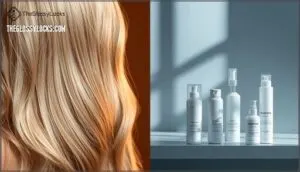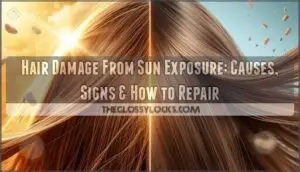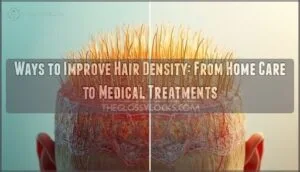This site is supported by our readers. We may earn a commission, at no cost to you, if you purchase through links.
 Golden blonde is warm. Platinum blonde is ice-cold. That seven-level gap between them isn’t just about pouring bleach on your hair and hoping for the best. Your hair’s current pigment concentration determines how many lifting sessions you’ll need, and skipping the prep work means you’ll trade your golden tones for a crispy, broken mess instead of that mirror-shine platinum you’re after.
Golden blonde is warm. Platinum blonde is ice-cold. That seven-level gap between them isn’t just about pouring bleach on your hair and hoping for the best. Your hair’s current pigment concentration determines how many lifting sessions you’ll need, and skipping the prep work means you’ll trade your golden tones for a crispy, broken mess instead of that mirror-shine platinum you’re after.
The transformation from golden to platinum requires understanding your hair’s structure, choosing the right lightening method, and protecting what you’ve got while you strip away those stubborn yellow pigments. This guide walks you through each critical step—from evaluating your hair’s health to selecting developer strength, applying bleach without creating hot spots, and toning out every trace of brass—so you can achieve that icy platinum finish without sacrificing your hair’s integrity.
Table Of Contents
- Key Takeaways
- How to Prepare Hair for Platinum Blonde
- Choosing The Right Lightening Method
- Step-by-Step Platinum Blonde Transformation
- Toning Hair for an Icy Platinum Finish
- Maintaining and Caring for Platinum Blonde Hair
- Frequently Asked Questions (FAQs)
- How Long Will It Take to Achieve Platinum Blonde Hair?
- How Much Bleach Do I Need?
- What Are the Benefits of Using a Bond Building Shampoo and Mask?
- Is It Necessary to Use a Vaseline to Avoid Staining?
- Can I skip bleaching and go straight platinum?
- How long between bleaching sessions is safe?
- Will platinum blonde work on previously dyed hair?
- What causes green tones in platinum blonde hair?
- How often should I refresh my platinum color?
- Conclusion
Key Takeaways
- Transitioning from golden blonde (level 8) to platinum (level 10) requires multiple bleaching sessions spaced two weeks apart, with each session lasting 2-6 hours, because rushing the process trades your hair’s integrity for breakage instead of achieving that icy finish.
- A bleach bath using a 1:2:1 ratio of powder, developer, and clarifying shampoo cuts cuticle damage by roughly 25% compared to full-strength formulas while still lifting underlying tones one to two levels per session.
- Toning is non-negotiable after bleaching—violet-based toners neutralize yellow tones by about 82% on levels 8-10, while blue-based toners tackle orange undertones in levels 6-7, and choosing wrong creates green disaster zones.
- Maintaining platinum demands vigilant care including weekly purple shampoo to prevent brassiness, alternating deep conditioning with protein treatments every 3-4 days to rebuild broken bonds, and trimming every 6-8 weeks to slash split ends by 40%.
How to Prepare Hair for Platinum Blonde
Getting your hair ready for platinum blonde takes a little planning and care. Before you start, it’s important to make sure your hair is healthy and prepared for the process. Here’s what you should focus on first.
Assessing Hair Health and Condition
Before you chase icy platinum, checking hair condition is key. Check for signs of hair brittleness, weak elasticity, and compromised cuticle integrity—think roughness or breakage. Run a stretch test for elasticity indicators. If hair snaps or feels dry, protein stability and moisture balance are off.
Watch for scalp sensitivity, too, since bleach can increase irritation and damage. Bleach can strip hair of natural oils, leading to further cuticle damage.
Removing Product Buildup and Old Color
Once your hair passes the health check, clear away what’s holding it back. Product buildup from styling products, oils, and hard water minerals creates a barrier that blocks bleach from working evenly. Clarifying shampoos strip surface residue using surfactants, restoring up to 85% of natural shine. For hard water or chlorine, chelating shampoos target mineral deposits with EDTA. If you’re removing existing hair color, acid removers shrink artificial pigment molecules without damaging natural melanin.
A pre-lightening cleanse ensures even bleach penetration and prevents patchy results. Always perform a strand test to check underlying tones before moving forward. Build-up can occur from film-forming ingredients, such as waxes and butters.
Strengthening Hair With Protein Treatments
After clearing buildup, give your strands some backbone. Keratin benefits are real—this protein restores up to 80–90% of tensile strength lost during bleaching, cutting breakage risk sharply.
Apply a hydrolyzed keratin treatment once weekly for four weeks before lightening. That regimen boosts resilience by roughly 25%.
Watch for protein overload, though—too much causes brittleness. Balance is key: alternate protein treatments with moisture to keep hair flexible and strong.
Gathering Essential Lightening Supplies
Now you’re ready to actually lighten. Start with professional bleach powder that lifts up to 7 levels—Platinum Blonde Bleaching Powder is solid. Pair it with a 20–30 volume developer for controlled lift without frying your hair.
Grab non-metallic mixing tools, nitrile gloves for safety gear, and a neutralizing mask to stop the oxidation process after lightening. A digital scale keeps your ratios spot-on—1 part bleach powder to 2 parts developer.
Choosing The Right Lightening Method
Getting from golden blonde to platinum isn’t just about slapping on bleach and hoping for the best. The method you choose makes all the difference between hair that shines like ice and hair that snaps off at the roots.
Let’s break down your options so you can pick the right approach for your hair.
Understanding Hair Color Levels
Before you pick up bleach, you need to understand where your hair sits on the color scale. Hair color levels run from 1 (black) to 10 (lightest blonde), and melanin concentration determines each shade. Golden blonde generally sits around level 8, while platinum requires reaching level 10.
That level difference matters because it dictates your developer volume and toning impact later. A strand test reveals your starting point and how your hair reacts, which genetic control over pigment affects uniquely for everyone.
Selecting Bleach Vs. High-Lift Dye
Once you understand your starting level, you’ll face a critical fork in the road: bleach or high-lift dye. Both lighten hair, but they work differently and deliver distinct results based on your hair’s history and your platinum goals.
- Lifting capability: Bleach achieves 7–9 levels of lift, while high-lift dye maxes out at 4–5 levels on virgin hair.
- Damage comparison: High-lift formulas skip harsh persulfate compounds, causing less structural harm than bleach.
- Virgin hair: High-lift only works on untreated strands; bleach lifts both natural and color-treated hair.
- Toning needs: Bleach always requires a separate toner, but high-lift dye deposits ash tones during lightening.
For golden blonde aiming at platinum, bleach remains your most reliable lightener despite the higher damage risk.
Deciding on Developer Strength
How do you choose the right developer strength without turning your golden blonde into a fried disaster? Volume selection depends on hair porosity and your damage control strategy.
A 20 volume developer lifts 1–2 levels with moderate cuticle opening, making it ideal for gradual lifting on treated hair. If your strands are resilient, 30 volume achieves 2–3 levels of lift—enough for platinum.
Root application always uses lower volume since scalp heat accelerates hair bleaching by 25–30%, reducing hair damage while hair lightening proceeds safely.
Performing a Strand Test
A strand test is your safety net before bleaching—it predicts lift potential and prevents hair damage from over-processing. Pull a quarter-inch section from under your top layer and apply your bleach mixture exactly as planned for the full application.
Here’s what to monitor during the test:
- Porosity Effects and Prior Treatments: Chemically treated hair lifts faster but breaks more easily—check elasticity by stretching the strand after rinsing.
- Timing Accuracy: Evaluate hair color every 10 minutes; processing times between 10–60 minutes reveal how quickly your hair lightening progresses.
- Lift Evaluation and Tone Neutralization: Compare results under natural light to confirm you’ve reached level 10–11 for achieving platinum blonde hair, then choose violet or blue toners based on remaining brassiness.
Document your results—timing, ratios, and final tone—before committing to full-head hair bleaching.
Step-by-Step Platinum Blonde Transformation
Now that you’ve prepared your hair and selected your lightening method, it’s time to transform that golden blonde into platinum.
The process requires precision and patience to avoid damage while lifting your hair to the lightest possible shade. Follow these steps carefully to achieve an icy, professional-looking result.
Applying Bleach or Lightener Evenly
Even application separates salon-worthy results from patchy disasters. Divide your hair into four to six sections using clips—this ensures balanced product saturation and cuts under-processed spots by 35%.
Apply bleach to mid-lengths and ends first, leaving roots for last since scalp heat speeds lift by 10–15%. Work quickly in thin subsections, saturating each strand completely to avoid banding. Use foils to maintain even heat distribution throughout the bleaching process.
Monitoring Processing Time and Rinsing
Watching your bleaching process like a hawk cuts hair damage risks in half. Check your strands every 10–15 minutes with a scrape test—wipe a small section to reveal true lightness without rinsing everything. You’re aiming for pale yellow, like banana peel interior, not rubbery texture or burning sensations (over-processing signs).
Rinse with cool water until it runs clear, then shampoo twice. Apply a pH-balancing hair treatment immediately post-rinse to restore cuticle integrity before toning.
Using a Bleach Bath for Minimal Damage
A bleach bath dilutes the bleaching process using a 1:2:1 ratio of powder, developer, and clarifying shampoo, cutting cuticle damage by roughly 25% compared to full-strength formulas. This gentler hair lightening process lifts underlying tones one to two levels per session, protecting protein retention and minimizing brittleness.
Why a bleach bath beats standard bleaching:
- Dilution ratios slash peroxide exposure, preserving up to 40% more cuticle integrity
- Wet application speeds lift in 10–20 minutes, not 45, limiting oxidative stress
- Gradual lightening prevents structural voids and keeps tensile strength higher
- Cuticle protection leaves smoother surfaces with fewer cracks than traditional bleach
Mix your formula, apply to damp strands, and monitor closely—you’re trading speed for hair health.
Avoiding Over-Processing and Breakage
Your bond-repair treatments are most crucial when developer strength exceeds 20 vol, as this is when protein degradation accelerates and microstructural integrity is compromised. Monitor processing time closely; rinse immediately upon noticing a pale yellow hue to prevent further hair damage. Adding bond builders mid-bleach can significantly reduce breakage by reconnecting sulfur bonds before they are permanently lost.
| Over-Processing Warning Sign | Immediate Action |
|---|---|
| Gummy, stretchy texture | Rinse instantly, apply protein mask |
| White or translucent ends | Stop all lifting, begin post-bleach recovery |
| Snapping during combing | Deep condition, skip further processing |
Toning Hair for an Icy Platinum Finish
After bleaching, your hair needs toning to transform brassy yellow tones into that cool, icy platinum you’re after. This step neutralizes unwanted warmth and locks in the crisp, white-blonde finish.
Here’s how to identify the right toner, apply it properly, and maintain your platinum color at home.
Identifying and Neutralizing Yellow or Brassy Tones
After bleaching, brassy yellow or orange tones appear because UV radiation, hard water, and pigment oxidation break down your hair’s artificial color. Here’s what causes brassiness:
- UV exposure degrades pigments and lightens hair up to two tonal levels over 6–8 weeks
- Copper levels above 300 ppb in hard water catalyze oxidative discoloration
- Heat styling above 200°C accelerates pigment breakdown within two weeks
Neutralizing yellow tones requires violet products or a violet-based toner, since violet sits opposite yellow on the color wheel. Toning at the best toning pH of 4.5–5.5 lets pigments deposit effectively.
Purple shampoo reduces yellow intensity by about 42% through temporary violet dye deposition on your hair’s cuticle.
Choosing The Right Toner (Violet Vs. Blue-Based)
Once you’ve neutralized yellow with violet-based products, undertone identification determines your next move. Violet-based toners work best on levels 8–10, where yellow dominates, reducing yellowness by about 82%. Blue-based toners tackle orange undertones in levels 6–7, cutting orange chroma by 76%. If you’re seeing mixed yellow-orange tones, a 1:1 blue-violet blend addresses both.
Your pigment composition matters too—violet toners use basic violet 2, while blue toners rely on ultramarine pigments that bind to keratin.
For toner safety, stick to pH-balanced formulas and avoid overuse to prevent staining. Maintenance frequency of four to six weeks keeps your platinum sharp between toning sessions.
How to Apply Toner Correctly
With your bleach-washed base ready, toning hair after bleaching demands precision and speed. Work through these steps for an icy finish:
- Toner Mixing: Combine one part violet-based toner or blue-based toner with two parts 10–20 volume developer using a whisk for lump-free consistency.
- Application Speed: Section hair into four to six parts, then apply purple toner or your chosen formula roots-to-ends within five minutes to prevent banding.
- Rinsing Technique: Monitor every five minutes for up to twenty minutes, then rinse with cool water to seal the cuticle and lock in tone.
Porosity concerns? Use a clarifying shampoo beforehand to balance absorption. Corrective strategies include strand tests to avoid over-toning.
Recommended At-Home Toners and Purple Shampoos
Your platinum pursuit hinges on smart toner formulations and consistent maintenance trends. Violet-based toner options like Ugly Duckling’s Intense Pearl Blonde 100V neutralize yellow tones, while blue-based toner choices such as Pravana ChromaSilk tackle orange undertones.
Purple shampoo, used weekly, prevents brassiness without darkening your platinum blonde hair—shampoo overuse causes gray buildup.
Product longevity improves when you pair toners with conditioning masks, extending pigment efficacy by two weeks.
Maintaining and Caring for Platinum Blonde Hair
You’ve nailed the platinum blonde look, but the real work starts now.
Platinum hair needs consistent care to stay vibrant and healthy. Here’s what you need to focus on to keep your new color looking fresh and your strands strong.
Deep Conditioning and Protein Treatments
Your hair’s internal structure takes a hit during lightening—think of it like scaffolding that needs rebuilding. Deep conditioner restores lost moisture, cutting breakage by up to 40% when used weekly. Protein treatments with hydrolyzed keratin repair broken bonds, boosting fiber strength by 35%. Look for best ingredients like argan oil, hyaluronic acid, and amino acids for maximum hair repair.
Alternate protein-based and moisture masks every 3–4 days initially to prevent stiffness. Bond-repair treatments and newer innovations like disulfide regeneration compounds offer improved damage prevention, keeping your platinum vibrant longer.
Weekly Use of Purple Shampoo and Masks
Think of purple shampoo as a weekly tune-up that keeps brass from crashing your platinum party. Use it once weekly to neutralize yellow tones through violet pigments—more than that risks over-depositing and dull, grayish results.
Purple masks offer deeper tone neutralization plus moisture restoration, balancing mask pH while repairing bleach damage.
Alternate both products to prevent hard water effects and maintain your regimen integration. This consistent approach to maintaining platinum blonde hair and color-treated hair keeps your icy finish vibrant for 6–8 weeks between touch-ups.
Protecting Hair From Heat and Environmental Damage
Your platinum blonde locks face enemies on all sides—heat styling damage above 350°F denatures keratin and cuts strength by 30%, while UV exposure effects and pollution impact double the assault.
Apply heat protectant before every styling session to reduce moisture loss by 20–30%, and limit tools to under three times weekly.
Bond builders and weekly deep conditioning restore elasticity lost to heat and environmental stressors, keeping hair breakage at bay while minimizing damage from the sun’s rays and urban air.
Regular Trims and Damage Prevention Tips
Trimming every six to eight weeks isn’t optional—it’s your platinum blonde lifeline. Regular cuts slash split ends by 40% and stop hair breakage from creeping upward.
Pair trims with bond-repair treatments for repair synergy that boosts elasticity by 30%, reinforcing structural integrity.
This trimming frequency maintains long-term strength, keeping cuticles smooth and damage prevention locked in for months ahead.
Frequently Asked Questions (FAQs)
How Long Will It Take to Achieve Platinum Blonde Hair?
You might think achieving platinum blonde hair happens overnight, but the reality is different.
For golden blonde hair, expect one to two bleaching sessions spaced two weeks apart, with each session duration lasting two to six hours including toning. Hair porosity and chemical impact greatly affect this timeline.
How Much Bleach Do I Need?
You’ll need 2-4 ounces of bleach powder and 4-8 ounces of developer for medium-length hair using a 1:2 ratio.
Hair length, starting level, and hair porosity affect how much you’ll actually use during the bleaching process.
What Are the Benefits of Using a Bond Building Shampoo and Mask?
Bond-building treatments are like insurance for your hair—repairing disulfide bonds broken during bleaching. These treatments restore hair strength up to 80%, preventing heat damage while improving manageability.
Regular bond-repair treatments offer environmental protection, boosting hair health and resilience by 20-40% for lasting hair repair.
Is It Necessary to Use a Vaseline to Avoid Staining?
Applying Vaseline along your hairline protects skin from hair dye stains. The petroleum jelly creates a barrier preventing dye molecules from binding to skin.
Natural oil barriers and commercial protectors work similarly, giving you application confidence when protecting hair during coloring.
Can I skip bleaching and go straight platinum?
No, you can’t skip bleaching. Non-bleach options won’t lift golden blonde hair to true platinum.
High-lift dyes may lighten slightly, but they produce brassy or uneven tones without the pigment removal bleaching provides.
Alternative methods result in color limitations and disappointment.
How long between bleaching sessions is safe?
Wait at least six to eight weeks between bleaching sessions for damage assessment and scalp health recovery.
This interval allows your hair structure to rebuild proteins and prevents overprocessing, greatly reducing breakage risk.
Will platinum blonde work on previously dyed hair?
Platinum blonde hair can work on previously dyed hair, but uneven lifting, porosity concerns, and increased hair damage are common challenges.
Dye removal or color correction may be needed first to prevent patchy results and control breakage during the hair dyeing process.
What causes green tones in platinum blonde hair?
Green tones in platinum blonde hair happen when chlorine or copper deposits react with your hair’s high porosity after bleaching. Toning errors—like using a blue-based toner instead of a violet-based toner—can also create unwanted green hues, as can certain product reactions that deposit minerals onto brassy tones.
How often should I refresh my platinum color?
Your platinum blonde hair needs root touch-ups every four to six weeks as hair regrowth shows, while toner lifespan lasts two to six weeks.
Use purple shampoo weekly and conditioning masks twice weekly to combat color fade and maintain vibrancy against environmental impact.
Conclusion
Getting platinum blonde hair from golden blonde isn’t about rushing through bleach sessions—it’s about respecting the process your hair demands. You’ve learned how to assess damage, choose the right developer strength, and tone out every trace of warmth.
Now you understand that platinum isn’t a single appointment; it’s a commitment to vigilant maintenance, protein treatments, and purple shampoo rituals. Your hair won’t forgive shortcuts, but it’ll reward patience with that mirror-shine finish you’re chasing.
- https://www.uglyducklingcolor.com/content/74-how-do-you-get-platinum-blonde-hair
- https://shesthickhaircare.com/blogs/news/the-long-term-effects-of-bleaching-your-hair-or-getting-blonde-highlights
- https://purespadirect.com/blogs/pure-spa-direct-blog/as-a-colorist-should-i-always-use-toner-for-blondes
- https://www.jillianelise.com/blog/platinum-blonde-hair-a-diy-guide
- https://www.hadviser.com/best-products-for-bleached-hair/










